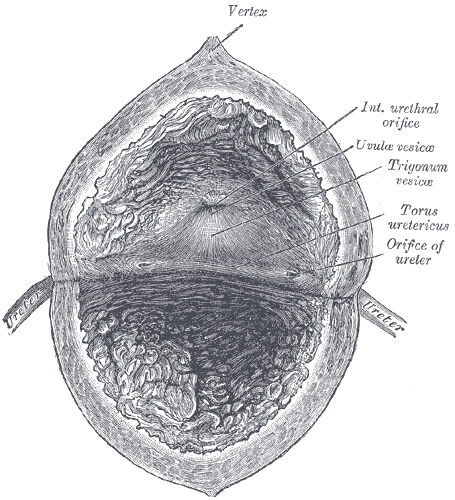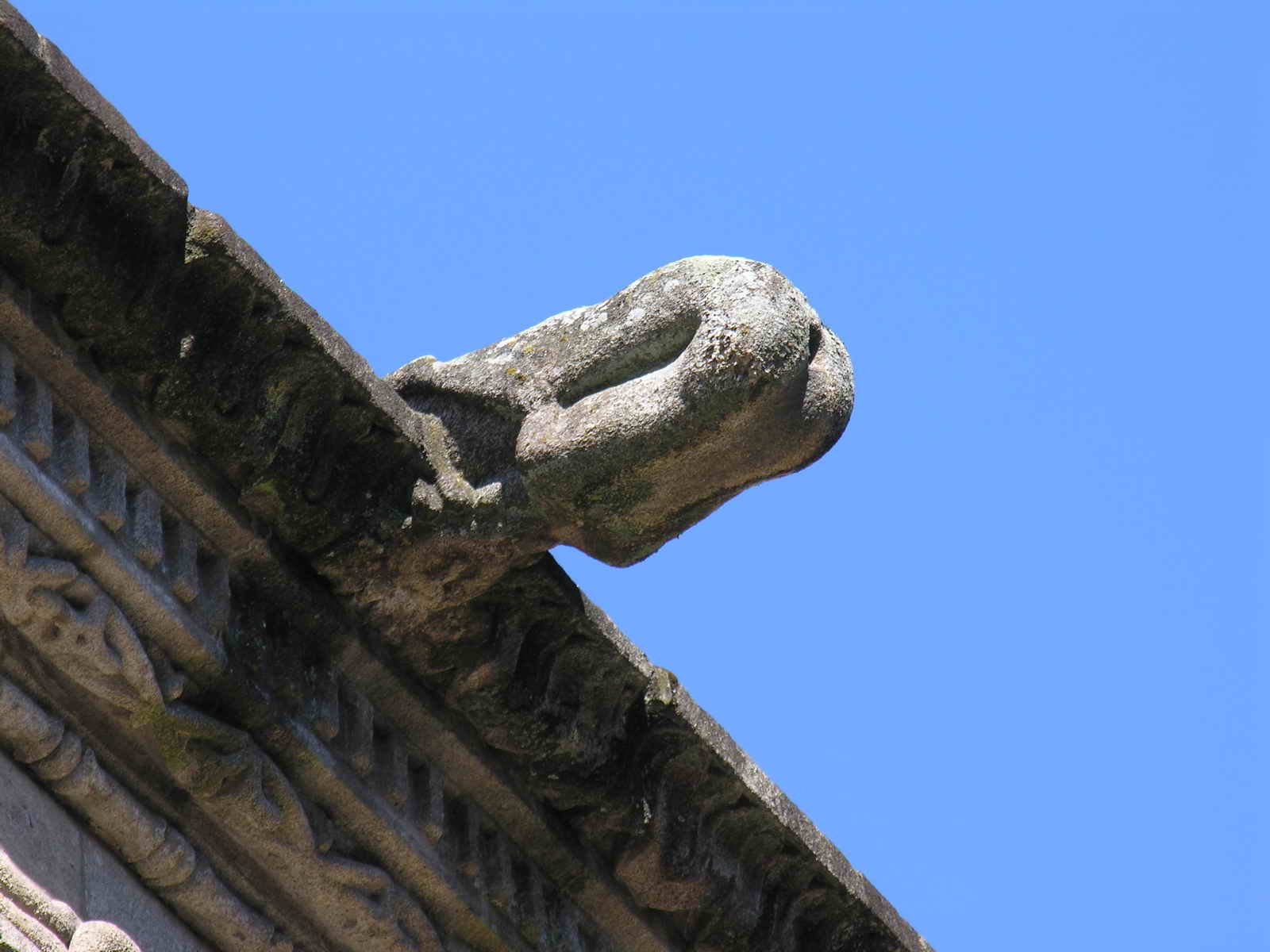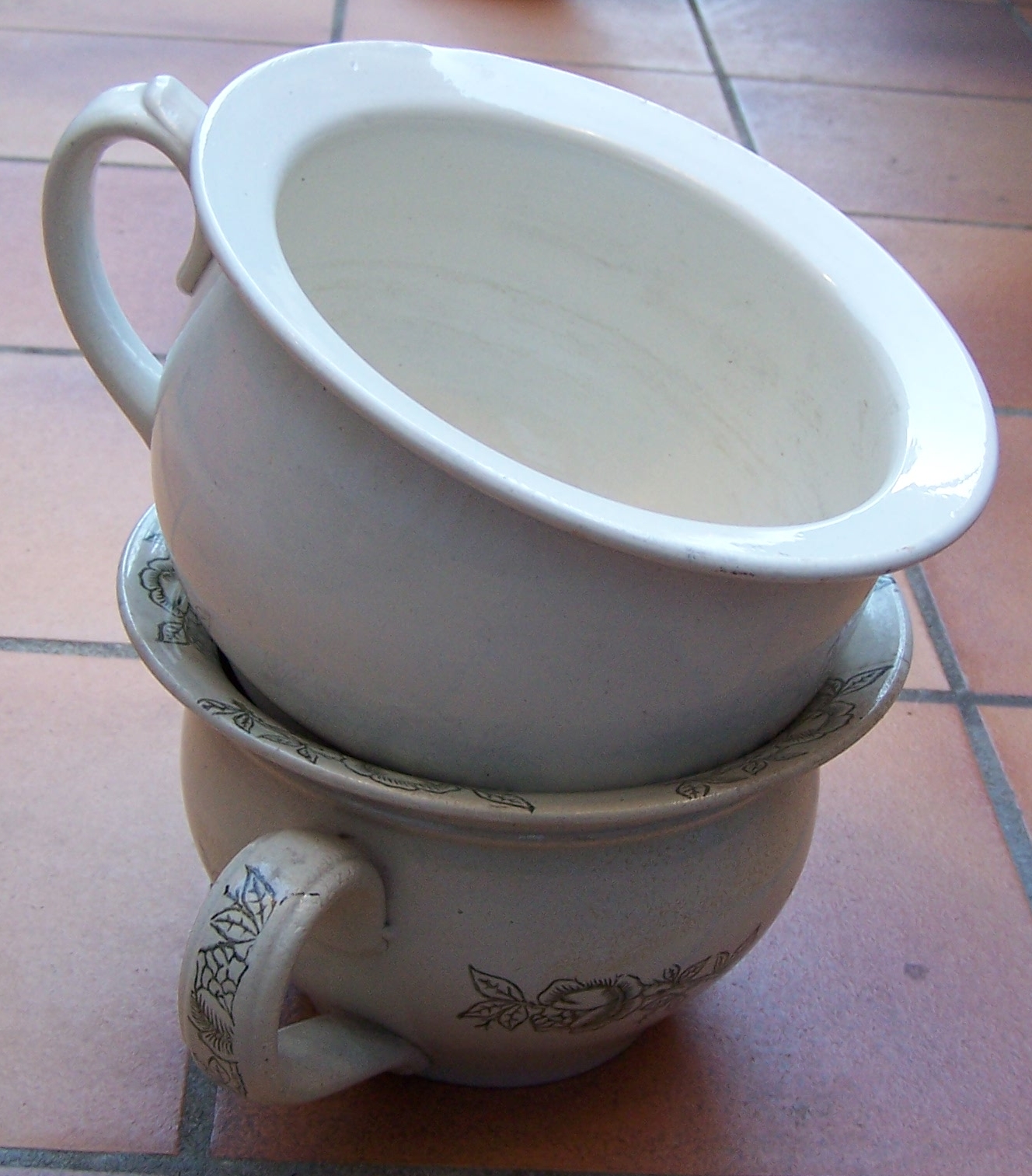Urination
Template:Search infobox Steven C. Campbell, M.D., Ph.D.
Overview
Urination, known by physiologists as micturition, or more simply as voiding, is the process of disposing urine from the urinary bladder through the urethra to the outside of the body. In healthy adults, the process of urination is under voluntary control; in infants and individuals with neurological injury, urination may occur as an involuntary reflex.
Terms
Urination is often referred to as "peeing", a euphemism for "piss" which is considered more vulgar. It is also referred to as "weeing" in the UK. "To whiz" or "whizzing" is common in the U.S. Others of note are "tinkle" and "potty" - both of which are often used with children.
Anatomy of the bladder and outlet

The main organs involved in urination are the bladder and the urethra. The smooth muscle of the bladder, known as the detrusor, is innervated by sympathetic nervous system fibers from the lumbar spinal cord and parasympathetic fibers from the sacral spinal cord. [1] Fibers in the pelvic nerves constitute the main afferent limb of the voiding reflex; the parasympathetic fibers to the bladder that constitute the excitatory efferent limb also travel in these nerves. Part of the urethra is surrounded by the external urinary sphincter, which is innervated by somatic fibers originating in the sacral cord, in an area termed Onuf's nucleus[2].
Muscle bundles pass on either side of the urethra, and these fibers are sometimes called the internal urethral sphincter, although they do not encircle the urethra. Farther along the urethra is a sphincter of skeletal muscle, the sphincter of the membranous urethra (external urethral sphincter). The bladder epithelium is made up of a superficial layer of flat cells and a deep layer of cuboidal cells.
Physiology of urination
The physiology of micturition and the physiologic basis of its disorders are subjects about which there is much confusion, especially at the supraspinal level. Micturition is fundamentally a spinobulbospinal reflex facilitated and inhibited by higher brain centers and, like defecation, subject to voluntary facilitation and inhibition.[3]
In healthy individuals, the lower urinary tract has two discrete phases of activity: the storage phase, when urine is stored in the bladder; and the voiding phase, when urine is released through the urethra. The state of the reflex system is dependent on both a conscious signal from the brain and the firing rate of sensory fibers from the bladder and urethra.[3] At low bladder volumes, afferent firing is low, resulting in excitation of the outlet (the sphincter and urethra), and relaxation of the bladder.[4] At high bladder volumes, afferent firing increases, causing a conscious sensation of urinary urge. When the individual is ready to urinate, he or she consciously initiates voiding, causing the bladder to contract and the outlet to relax. Voiding continues until the bladder empties completely, at which point the bladder relaxes and the outlet contracts to re-initiate storage.[3]
In infants, voiding occurs involuntarily (as a reflex). The ability to voluntarily inhibit micturition develops at the age of 2-3 years, as control at higher levels of the central nervous system develops. In the adult, the volume of urine in the bladder that normally initiates a reflex contraction is about 300-400 mL.
Storage phase
During storage, bladder pressure stays low, because of the bladder's highly compliant nature. A plot of bladder (intravesical) pressure against the volume of fluid in the bladder (called a cystometrogram) will show a very slight rise as the bladder is filled. This phenomenon is a manifestation of the law of Laplace, which states that the pressure in a spherical viscus is equal to twice the wall tension divided by the radius. In the case of the bladder, the tension increases as the organ fills, but so does the radius. Therefore, the pressure increase is slight until the organ is relatively full. The bladder smooth muscle has some inherent contractile activity; however, when its nerve supply is intact, stretch receptors in the bladder wall initiate a reflex contraction that has a lower threshold than the inherent contractile response of the muscle.
Action potentials carried by sensory neurons from stretch receptors in the urinary bladder wall travel to the sacral segments of the spinal cord through the pelvic nerves.[3] Since bladder wall stretch is low during the storage phase, these afferent neurons fire at low frequencies. Low-frequency afferent signals cause relaxation of the bladder by inhibiting sacral preganglionic neurons and exciting lumbar sympathetic preganglionic neurons. Conversely, afferent input causes contraction of the sphincter through excitation of Onuf's nucleus, and contraction of the bladder neck and urethra through excitation of the sympathetic preganglionic neurons.
As the bladder becomes full, afferent firing increases, yet the micturition reflex can be voluntarily inhibited until it is appropriate to begin voiding (e.g. a bathroom is reached).
Voiding phase
Voiding begins when a voluntary signal is sent from the brain to begin urination, and continues until the bladder is empty.
Bladder afferent signals ascend the spinal cord to the periaqueductal gray, where they project both to the pontine micturition center and to the cerebrum [5]. At a certain level of afferent activity, the conscious urge to void becomes difficult to ignore. Once the voluntary signal to begin voiding has been issued, neurons in pontine micturition center fire maximally, causing excitation of sacral preganglionic neurons. The firing of these neurons causes the wall of the bladder to contract; as a result, a sudden, sharp rise in pressure in intravesical pressure occurs. The pontine micturition center also causes inhibition of Onuf's nucleus, resulting in relaxation of the external urinary sphincter.[6] When the external urinary sphincter is relaxed urine flows from the urinary bladder when the pressure there is great enough to force urine to flow through the urethra. The micturition reflex normally produces a series of contractions of the urinary bladder.
The flow of urine through the urethra has an overall excitatory role in micturition, which helps sustain voiding until the bladder is empty.[7]
After urination, the female urethra empties by gravity. Urine remaining in the urethra of the male is expelled by several contractions of the bulbospongiosus muscle.
Voluntary control
The mechanism by which voluntary urination is initiated remains unsettled.[8] One possibility is that the voluntary relaxation of the muscles of the pelvic floor causes a sufficient downward tug on the detrusor muscle to initiate its contraction.[9] Another possibility is the excitation or disinhibition of neurons in the pontine micturition center, which causes concurrent contraction of the bladder and relaxation of the sphincter.[3]
There is an inhibitory area for micturition in the midbrain. After transection of the brain stem just above the pons, the threshold is lowered and less bladder filling is required to trigger it, whereas after transection at the top of the midbrain, the threshold for the reflex is essentially normal. There is another facilitatory area in the posterior hypothalamus. In humans with lesions in the superior frontal gyrus, the desire to urinate is reduced and there is also difficulty in stopping micturition once it has commenced. However, stimulation experiments in animals indicate that other cortical areas also affect the process.
The bladder can be made to contract by voluntary facilitation of the spinal voiding reflex when it contains only a few milliliters of urine. Voluntary contraction of the abdominal muscles aids the expulsion of urine by increasing the pressure applied to the urinary bladder wall, but voiding can be initiated without straining even when the bladder is nearly empty.
Voiding can also be consciously interrupted once it has begun, through a contraction of the perineal muscles and external sphincter can be contracted voluntarily, which will prevent urine from passing down the urethra.
Experience of urination
Need to urinate is experienced as an uncomfortable, full, feeling. It is highly correlated with the fullness of the bladder.[10] In males the feeling of the need to urinate can be sensed at the end of the penis, even though the neural activity associated with a full bladder comes from the bladder itself.
Release of urine is experienced as a lessening of the uncomfortable, full, feeling.
Post-micturition convulsion syndrome, the feeling of a shiver running down the spine following urination, occurs in more than 80% of men, but also occurs in more than 55% of women[11]. Its explanation is unknown.
Disorders of urination

Experimentally induced disorders
There are three major types of bladder dysfunction due to neural lesions: (1) the type due to interruption of the afferent nerves from the bladder; (2) the type due to interruption of both afferent and efferent nerves; and (3) the type due to interruption of facilitatory and inhibitory pathways descending from the brain. In all three types the bladder contracts, but the contractions are generally not sufficient to empty the viscus completely, and residual urine is left in the bladder. Paruresis, also known as shy bladder syndrome, is an example of a bladder interruption from the brain that often causes total interruption until the person has left a public area.
Effects of deafferentation
When the sacral dorsal roots are cut in experimental animals or interrupted by diseases of the dorsal roots such as tabes dorsalis in humans, all reflex contractions of the bladder are abolished. The bladder becomes distended, thin-walled, and hypotonic, but there are some contractions because of the intrinsic response of the smooth muscle to stretch.
Effects of denervation
When the afferent and efferent nerves are both destroyed, as they may be by tumors of the cauda equina or filum terminale, the bladder is flaccid and distended for a while. Gradually, however, the muscle of the "decentralized bladder" becomes active, with many contraction waves that expel dribbles of urine out of the urethra. The bladder becomes shrunken and the bladder wall hypertrophied. The reason for the difference between the small, hypertrophic bladder seen in this condition and the distended, hypotonic bladder seen when only the afferent nerves are interrupted is not known. The hyperactive state in the former condition suggests the development of denervation hypersensitization even though the neurons interrupted are preganglionic rather than postganglionic.
Effects of spinal cord transection
During spinal shock, the bladder is flaccid and unresponsive. It becomes overfilled, and urine dribbles through the sphincters (overflow incontinence). After spinal shock has passed, the voiding reflex returns, although there is, of course, no voluntary control and no inhibition or facilitation from higher centers when the spinal cord is transected. Some paraplegic patients train themselves to initiate voiding by pinching or stroking their thighs, provoking a mild mass reflex. In some instances, the voiding reflex becomes hyperactive. Bladder capacity is reduced, and the wall becomes hypertrophied. This type of bladder is sometimes called the spastic neurogenic bladder. The reflex hyperactivity is made worse by, and may be caused by, infection in the bladder wall.
Clinical conditions
Many clinical conditions can cause disturbances to normal urination. Here is a partial list:
- Urinary incontinence, or the inability to hold urine
- Stress urinary incontinence, incontinence that occurs as a result of external mechanical disturbances
- Urge urinary incontinence, incontinence that occurs as a result of the uncontrollable urge to urinate
- Mixed urinary incontinence, a combination of the two types of incontinence
- Urinary retention, the inability to initiate urination
- Overactive bladder, a strong urge to urinate, usually accompanied by detrusor overactivity
- Interstitial cystitis, a condition characterized by urinary frequency, urgency, and pain
- Prostatitis, a supposed inflammation of the prostate gland that can cause urinary frequency, urgency, and pain
- Benign prostatic hyperplasia, an enlargement of the prostate that can cause urinary frequency, urgency, retention, and the dribbling of urine
- Urinary tract infection, which can cause urinary frequency and dysuria
- Oliguria refers to a low urine output, usually due to a problem with the upper urinary tract
- Anuria refers to absent or almost absent urine output.
Urination techniques
Due to the differences in where the urethra ends, men and women use different techniques for urination.
Male urination
Due to the flexible and protruding nature of the penis, it is easy to control the direction of the urine stream. This makes it easy to urinate standing up, and most men urinate this way. The foreskin, if left in place during urination, may block the direct path of the outgoing stream by causing turbulence, resulting in a slower, but thicker stream of urine that may also dribble. Men who choose to retract their foreskin, or who have been circumcised, may have a more focused stream of urine that travels at the same speed it exits the urethra. When a man is done urinating, he will usually shake and/or gently squeeze his penis to expel the excess urine trapped in the opening of the foreskin or on the glans. This is known as "milking" the urethra. A common trick in expelling excess urine is gently pushing on the area behind the testicles (perineum).
Trousers usually have a fly allowing men to urinate without lowering the whole trousers. The fly has buttons or a zipper. Either just the fly is opened or also the fastening at the waist. Additionally, the fly of the underpants is used or their front-side is lowered. All combinations are possible. Trousers without fly, like some jogging trousers, have usually an elastic waist band allowing lowering the front side like underpants.
It is also possible for men to urinate sitting down. This is normally done when defecation has to take place as well. Some men also prefer to urinate this way.
Female urination
In women, the urethra opens straight into the vulva. Because of this, the urine does not exit at a distance from her body and is, therefore, hard to control. Because of surface tension in the urine, the easiest method is to just rely on gravity to take over once the urine has exited her body. This can easily be achieved if the woman is sitting down, although some women choose to squat or hover. Those alternative choices are sometimes made due to the perceived or actual unsanitary conditions at the location where the woman is urinating. When sitting, it helps if the woman leans forward and keeps her legs together, as this helps direct her stream downwards. When not urinating into a toilet, squatting is the easiest way for a woman to direct her urine stream. Some women use one or both hands to focus the direction of the urine stream, which is more easily achieved while in the squatting position.
Women who wear pants/trousers/shorts will need to lower the garment to facilitate urination. Women wearing skirts or dresses only need to raise them to their waists to urinate, just lowering the underpants. While urinating in the squatting position, pants are often just lowered to the midst of the thighs, and some women lift the midst of the lowered underpants up. Some women hold the midst of their underpants or bikinipants to the side, so that they do not have to lower them.
It is also possible for many women to urinate standing up by spreading their legs and pushing hard to avoid urine running down their legs. This technique for urinating while standing can be common when women often wear a sarong, skirt, or other such open bottomed garments, and either wear no underwear, or remove it. It is considered normal for women to urinate like this in many parts of Africa, whereas in contrast, it is not completely accepted in countries such as India where it also occurs in some areas. In Africa, even signs which forbid public urination often show a picture of a woman urinating while standing. [12]. It is mostly in West Africa, like Ghana and Nigeria, that it is considered normal for a female to urinate standing up. In many other parts it is mostly occurring in the countryside or not at all.
Though uncommon, it is possible for women to urinate standing up in a way similar to that of men. This may be done by spreading the labia minora open in a certain way and orienting the pelvis at an angle and rapidly forcing the urine stream out. [13] An alternative method is to use a tool to assist.[14]
Urination after injury
Occasionally, if a male's penis is damaged or removed, or a female's genitals/urinary tract is damaged, other urination techniques must be used. Most often in such cases, doctors will reposition the urethra to a location where urination can still be accomplished, usually in a position that would only promote urination while seated/squatting, though a permanent urinary catheter may rarely be used in some cases.
Social factors
Toilet training
Babies have no socialized control over urination within societies that do not practise elimination communication and instead use diapers. Toilet training is the process of learning to restrict urination to socially approved times and situations. Many young children suffer from nocturnal enuresis.[15]
Toilets

It is socially more accepted and more hygienic for adults and older children to urinate in a toilet. Public toilets are often separate for men and women, and may be partitioned for reasons of cultural modesty.
Urinals
Public restrooms may have urinals for men. The etiquette associated with two or more males using adjoining urinals varies, however [16][17]. Urinals for women, though rare, allow females to urinate while standing through the use of a special tool [18] or through the finger-assist method [19]. Urinals for either sex may have partitions between them in order to increase privacy. People with a mild form of paruresis, or "shy bladder syndrome," may have difficulty urinating in the presence of others and will consequently avoid using urinals directly adjacent to another person. Alternatively, they may opt for the privacy of a stall or simply avoid public restrooms altogether.
Social transgressions

A common transgression is urinating in the street (except at a public urinal). Often this is done after consumption of alcoholic beverage: the alcohol causes production of additional urine as well as a reduction of inhibitions. In New Orleans, urination on the street is sometimes referred to as a "New Orleans Piss". In most places, public urination is punishable by fine.
Urination can also be seen as a sign of disrespect or contempt for someone or something. In popular culture, signs of a cartoon figure (sometimes Calvin) urinating on another object (usually a car brand) are common.
In many countries and in many social classes even mentioning the need to urinate is seen as a social transgression, although the need is universal. Until recently in the UK many children were taught to say "I need a tidy" or "I need attention" when they needed to be taken to urinate. The abbreviations "tidy" or "tenny" were often used. Other euphemisms, such as 'Spending a penny" (a reference to coin-operated pay toilets); 'Going to see my aunt'; or 'Going to see a man about a dog' were used by adults. Even today adults may avoid stating that they need to urinate.
Urination in art can be seen as controversial.
Alternatives to toilets

Sometimes urination is done in a container such as a bottle, urinal, bedpan or chamber pot, e.g. in case of lying sick in bed, in the case that the urine has to be examined (for medical reasons, or for a drug test), or in the case that there is no toilet or it is inconvenient to go there, and no other possibility to dispose of the urine right away. See also Bedpan use and output measurement.
For the latter application a more expensive solution (hence for special occasions while traveling etc.) is a special disposable bag containing absorbent material that solidifies the urine in 5 to 10 seconds, making it convenient and safe to keep. It can also be used for vomiting. As well, it is not uncommon for people who do not have access to toilets to simply urinate on the ground. The local flora such as a tree or bush can be used for added privacy.
Urination fetishes
Some pornography depicts urination.
See also
References
- ↑ http://www1.va.gov/SpinalCordBoston/page.cfm?pg=21
- ↑ http://www.ncbi.nlm.nih.gov/sites/entrez?cmd=Retrieve&db=PubMed&list_uids=1374763&dopt=Citation
- ↑ 3.0 3.1 3.2 3.3 3.4 http://www.pubmedcentral.nih.gov/articlerender.fcgi?artid=1502389
- ↑ http://www.ncbi.nlm.nih.gov/sites/entrez?cmd=Retrieve&db=pubmed&dopt=AbstractPlus&list_uids=5248885
- ↑ http://www.ncbi.nlm.nih.gov/entrez/query.fcgi?cmd=Retrieve&db=PubMed&list_uids=7514777&dopt=Citation
- ↑ http://doi.wiley.com/10.1002/1096-9861(20010122)429:4%3C631::AID-CNE9%3E3.0.CO;2-M
- ↑ http://www.jurology.com/pt/re/juro/fulltext.00005392-199907000-00069.htm
- ↑ http://www.blackwell-synergy.com/doi/abs/10.1111/j.1464-410X.2007.06749.x
- ↑ http://www.springerlink.com/content/vr21603134r7ux15/
- ↑ S. Oliver, C. Fowler and A. Mundy et al., Measuring the sensations of urge and bladder filling during cystometry in urge incontinence and the effects of neuromodulation, Neurourol Urodyn 22 (2003), pp. 7–16.
- ↑ http://www.voltier.com/peeshiver/
- ↑ http://www.bigfoto.com/africa/ghana/ghana-66.jpg.
- ↑ "http://web.archive.org/web/20030604104917/http://restrooms.org/standing.html". External link in
|title=(help) - ↑ "http://www.travelmateinfo.com/page002.html". External link in
|title=(help) - ↑ Review of Medical Physiology, twentieth edition, William F. Ganong, MD
- ↑ http://double-plus-ungood.blogspot.com/2004/06/urinal-etiquette.html
- ↑ http://doctorvee.co.uk/2006/09/17/urinal-etiquette
- ↑ "http://www.travelmateinfo.com/page002.html". External link in
|title=(help) - ↑ "http://web.archive.org/web/20030604104917/http://restrooms.org/standing.html". External link in
|title=(help)
External links
Physiology of urination
- "Neurogenic Bladder" article on eMedicine
- Neurophysiology of Lower Urinary Tract Function and Dysfunction, Reviews in Urology
- "Urination" at HowStuffWorks.com
Urinary Incontinence
- An Article about stress incontinence and how to help it.
- An Article about what Urinary Incontinence is.
- Selected abstracts from recent medical literature on Urinary Incontinence.
- Urinary Incontinence Problems
bg:Уриниране cs:Močení de:Blasenentleerung eo:Urinado fa:ادرار it:Minzione nl:Urineren simple:Urination sk:Močenie yi:יורינע